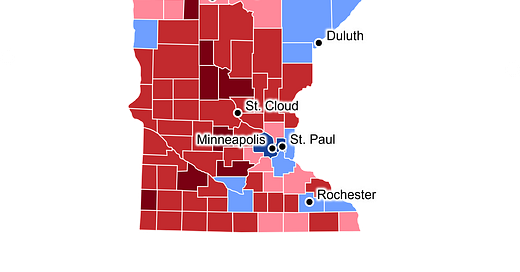Minnesota: Greater Minneapolis vs. Greater Minnesota
Minnesota's blue streak remains unbroken.
Topline Takeaways
Joe Biden continued Minnesota’s blue streak in presidential elections, marking the 12th time in a row that the state has supported a Democratic presidential candidate.
While Donald Trump saw an increase in his overall vote total compared to 2016, he lost ground in both the Minneapolis suburbs and the state’s historically Democratic “Iron Range” counties.
A tense summer of racial unrest preceded the 2020 election with Minneapolis at the epicenter. Despite Donald Trump’s attempts to turn fear into support for a “law and order” candidate, suburban voters supported Democrats more forcefully when compared to 2016.
In-Depth Insights
Minnesota possesses the longest Democratic voting streak in the nation for presidential elections; the last Republican candidate to win the state was Richard Nixon in 1972. This deep blue streak is due to the state’s unique political history. Democratic dominance can be traced all the way back to the merger of the Minnesota Democratic Party and the Minnesota Farmer-Labor Party back in 1944. (The official name of the party is currently the Minnesota Democratic-Farmer-Labor Party, DFL for short.) The merger brought together Democrats, progressive farmers and the state’s labor movement and leaned on a strongly-held belief in utilizing government to advance the public interest.
As the decades have passed, the Minneapolis-St. Paul metropolitan area has increased its influence on state politics. Today, more than half of all of the state’s voters live within the seven-county region governed by the Metropolitan Council. As a result, all candidates running in statewide elections must campaign hard in the state’s largest urban area to have a chance at winning. Biden sailed to a win via deep support in Hennepin county, the home of Minneapolis. He won the highest vote margin in the county for any presidential candidate since Theodore Roosevelt in 1904.
Joe Biden also saw increased support for the party in the northeastern “Iron Range”, complicating narratives that Donald Trump had flipped this historically Democratic region to Republicans in the 2016 election. While the area has many markers of quintessential “Trump country:” (heavily White population, mostly rural, resentment toward “big city” politics and/or “Washington”) the reality shows that many voters were not swayed by Trump’s tenure in the White House and cast doubts on claims that the Iron Range is “back in business” due to his actions.
Much of the support for Donald Trump came from “Greater Minnesota:” the portions of the state lying outside of the Minneapolis-St. Paul metropolitan area. The state’s rural areas are mostly populated by the type of White, working class voter that Republicans have focused intently on courting.
Donald Trump’s failure in Minnesota is largely due to his inability to hang on in the suburbs surrounding Minneapolis that have a history of voting for Republicans. Following the murder of George Floyd in Minneapolis and the ensuing protests, Trump tried his best to foment fear among moderate suburban voters, leaning in on images of rioting and looting to help bolster his platform as the “law and order” candidate. These voters didn’t take the bait and instead supported Joe Biden more forcefully than they supported Clinton in 2016. In 2016 Donald Trump won the state’s 2nd congressional district, home to much of the suburbs lying south of these cities, by 1.2 points; in 2020 he lost it to Biden by over 6 points.
Forecasting the Future: While Democrats can enjoy their continued successes in Minnesota, the disappearance of split-ticket voting may be a sign of trouble for the party in Greater Minnesota. In the 2016 election, many rural Minnesota voters supported Donald Trump at the top of their ballot but continued to support other Democratic candidates. In 2020, many of these areas where Trump has cemented his support saw more seats change parties. Donald Trump won the state’s 7th congressional district in both 2016 and 2020 but the seat changed hands after the incumbent, Collin Peterson lost to Republican candidate Michelle Fischbach in 2020. While the DFL still holds the governorship and a majority in the state House, they lost four seats to Republicans in the 2020 election, all lying outside of the Twin Cities metro area.





